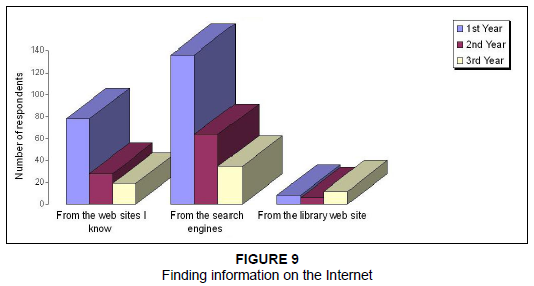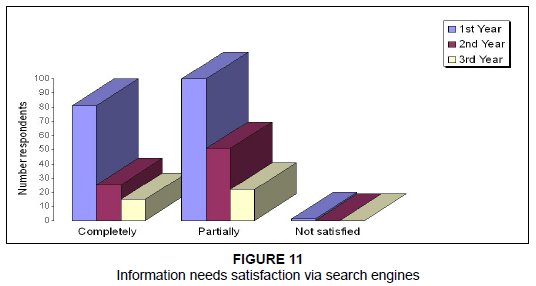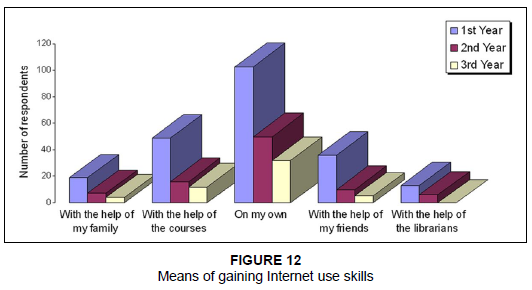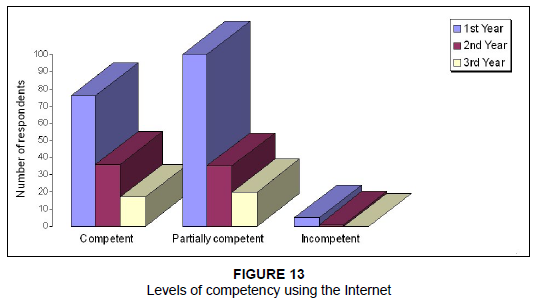|
According to Uçak (2007:697), 'it is important to explore the information behaviours of
the students who are being educated in the field of information management since the role they are
going to play in establishing connections between information sources and users is crucial'. This study
focuses on the identification of the information seeking behaviour of students in the department of Information
and Knowledge Management at the University of Johannesburg, South Africa. The research is
based on research conducted at the Hacettep University in Ankara, Turkey.
According to Prensky (2001), the onset and rapid diffusion of Information and Communication Technology (ICT)
in the last decade of the 20th century has brought about a 'singularity' or 'an event which changes things so
fundamentally that there is absolutely no going back' in the way the modern man thinks, communicates and
interacts within their environment. Nicholas et al. (2003:23) concurs and adds that it is 'not just the number
of people using the system that changed so dramatically, the types of people using the system
changed dramatically too…'. According to Spink (2004:336), 'the growing complexity of everyday
life and work environments often requires people to engage in multitasking behaviours'. Taking this statement
into consideration, the importance of determining the information searching habits of students within this hyper-connected
environment becomes evident.
Research problem
it is important to explore the information behaviours of the students who are being educated in
the field of information management since the role they are going to play in establishing connections
between information sources and users is crucial. ( Uçak 2007:697) The research problem for this study can be formulated as an attempt to explore the information seeking habits of
Information and Knowledge Management students at the University of Johannesburg. In answering the research problem, various concepts relating to information searching behaviour require definition.
|
Information Seeking Behaviour
|
|
Spink and Cole (2006:25) are of the opinion that human beings have been seeking and using information for survival
in various contexts for millennia. According to Johnstone et al. (2004), the rapid diffusion of ICT has created
a gap between the production of information via information systems and the processing and use of information by end-users.
Johnstone et al. (2004) states that the indentified gap is filled by human behaviour in closing the space between the
information generated and information processed. Wilson (2000:49) states that 'information behaviour is the totality of human
behaviour in relation to sources and channels of information, including both active and passive information seeking and information
use'. Steinerová and Šušol (2007) recognise this and adds that 'human information behaviour is an integrated activity at various
levels of information processing and use'. Taking this into consideration, Wilson (2000:49) indicates that information seeking behaviour
can be defined as the persistent quest for information with a specific goal in mind. Johnstone et al. (2004)
states that information seekers will examine the information generated from information systems and will apply cognitive
procedures to determine the next step in the information processing cycle. The various steps (including updating, storing,
discarding and/or sharing of information) in the information processing cycle will be determined by the information seeker's
frame of reference. Considering the clarification of the concept 'information seeking', the next section will focus on the identification of some
categories of information seekers with specific reference to digital natives and digital immigrants within the hyper-connected
digital age as postulated by Marc Prensky (2001).
|
Digital natives vs. digital immigrants
|
|
The information behaviour of Information and Knowledge Management students have been chosen in an attempt to ensure
that these students are equipped to link information with the specific use and goals of the individual and/or the organisation. Marc Prensky, in his seminal article entitled Digital Natives, Digital Immigrants published in 2001,
identified a new class of students entering educational institutions world wide. The following section will
define and illustrate the concepts of digital natives and digital immigrants.
Digital immigrants
It can be stated that world culture has been dominated for the last three decades by the Baby Boomer generation.
According to the Oxford English Dictionary Online, a baby boomer is defined as a person born during the post-World War
II baby boom (i.e. the years between 1939 and 1945). Gaston (2006:12) adds that 'the baby boomers were the generation
that grew up with television and it had an impact in both directions. Television shaped the boomers, and the
boomers shaped television'. Those of us who were not born into the digital world, but have at some point later in our
lives become fascinated by technology and have adopted many or most aspects of the new technology, are and always will
be compared to the baby boomers. Rockett and Powell (2008) are in agreement with the statement postulated by Gaston and
add that '[D]igital Immigrants are people who have less experience with technology in general'. Prensky (2001) identifies the following characteristics or traits of digital immigrants:
• Digital immigrants will use the Internet and World Wide Web as last resort in sourcing information.
• Digital immigrants will read manuals to computer programmes instead of relying on the computer programme to
teach the immigrant how to use the computer programme.
• Digital immigrants print emails instead of reading it online.
• Digital immigrants need to edit electronic documents in printed format.
Digital Natives
Coined by Tapscott (1999) as the 'Net Generation', (from pre-school to university-level students),
this concept represents the first generation to grow up in a global environment that was already connected
and linked before they were born. They have spent their entire lives surrounded by and using computers, videogames, digital music players, video games,
cellular phones, and all the other toys and tools of the digital age. (Prensky, 2001) Prensky agrees with Tapscott on the designation of this segment of the global community and adds that because
these individuals are all 'native speakers' of the digital language of modern ICT, they can also be referred to
as digital natives. Ask any parent, teacher or librarian and they will recognise that the Net generation has,
to a large extent, been influenced by the ambient or digital pervasive environment of the 21st century.
Observing this new generation within this pervasive environment will reveal a large percentage of these
individuals engaging and being in control of the tools and toys of the digital pervasive environment,
such as cellular phones, iPods and Sony PlayStation Portables (PSP). According to Gaston (2006:12), 'in their world, the consumer of information is in charge - not the producer',
and states furthermore that, 'a common thread that runs through each of these services (or technologies) is a very high
level of near-instantaneous interactivity controlled by the consumer'. A considerable amount of effort and research
has gone into defining the aforementioned individuals: [T]his group of individuals, born roughly between 1980 and 1994, has been characterized by their familiarity
with and reliance on Information and Communications Technologies (ICTs). (Kennedy, et al. 2006) For the purpose of this article, the term coined by Marc Prensky will be used
to refer to 'Digital Natives'. According to Prensky, Digital Natives may be defined as the 'native speakers
of technology, fluent in the digital language of computers, video games, and the Internet', (Prensky 2005a:8): The former group's interaction with new technologies can reach durations of 10,000-20,000 hours in the
first 20 years of their lives; today's neuroscience tells us that this degree of input is almost certain
to have caused measurable physical change to their brains.(Prensky 2005a:8) It is therefore evident that digital natives do not have the patience for asynchronous communication and/or
searching for information. Before determining the information searching habits of digital natives, it is
necessary to identify their characteristics.
Distinguishing characteristics of Digital Natives
The previous section focussed on describing the concept of a Digital Native. The following section
will focus on identifying certain distinguishing characteristics of digital natives and can include
some of the markers that distinguish digital natives from digital immigrants (Long, 2005:188 & van Slyke, 2003): • Digital natives are used to the speedy delivery of information.
• Digital natives do not need comprehensive instruction on using or interacting with technology.
Digital natives collaborate and learn in diverse ways. Learning is not seen as a serious matter any longer.
• Digital natives are capable of multitasking and prefer to do so.
• Digital natives prefer graphics to text.
• Because of the hyper connectedness of the environment wherein digital natives operate,
they prefer random access via hypertext.
• The hyper connected environment facilitates network formation and collaboration; it can
therefore be stated that the digital native functions best when networking.
• Digital natives thrive on instant gratification and regular rewards.
|
Multitasking and the engagement of Digital Natives
|
|
This section will focus on the increased ability of digital natives to multitask and how
they engage within their particular environment. Miwa (2001) suggests that information behaviour is
fundamentally motivated by imposed, as well as socially and personally generated goals and objectives. Spink et al. (2002), concurs and adds that the practice of seeking information within the ever
changing technological environment may be referred to as, 'multitasking information behaviour'. Taking note
of and building on the multitasking behaviour of digital natives, Prensky (2005b:62) writes that all digital natives
'have something in their lives that's really engaging- something that they are good at, something that has an engaging,
creative component to it'. This can include mixing, downloading and organising songs and/or PodCasts on their iPods,
playing games on their PSPs; creating, uploading and downloading of homemade movies via YouTube or playing online strategy games. The question arising from this is what are the information seeking habits of digital natives? It should be noted that
this article is based on research conducted in the department of Information Management at the Hacettepe University in Ankara,
Turkey. Furthermore, this article forms part of a larger study where the results of the Ankara research will be compared to the
results obtained from the Johannesburg study.
This study is based on a questionnaire that was distributed to 200 students in the department of
Information Management at the Hacettepe University in Ankara, Turkey. According to Uçak (2007) The questions were designed to solicit information about the purpose for which they [students] seek information,
how they meet their information needs, their frequency of use and the purpose for which they use the Internet,
where they can access the Internet, the qualities they look for in the information they find, which search engine
they use most frequently, and, finally, their knowledge and skills in relation to the Internet. ( Uçak 2007:698) Written permission from the original author was obtained prior to use and distribution of the questionnaire. In total, 289 students from the University of Johannesburg completed questionnaires, which constitute a representation
of 29.34% of the sample. This number of questionnaires excludes 60 incomplete questionnaires.
A total of 289 completed questionnaires were received. Of the 289 students that completed the questionnaire,
169 students were female (58.5%) and 120 were male (41.5%) (Figure 1). It is evident from these statistics that
the ratio between female and male participants does not vary greatly. It should be noted that the effect of gender
on behaviour is not investigated. The research participants represented different directions of study and included 87% BA students, 9.6% B.Com students,
3.1% BSc students and 0.3% of students having indicated Other as qualification option. The high ratio of BA students might
be attributed to the fact that Information Management is a specific subject within the Arts Faculty (Figure 2).
The need for information
The question posed to the respondents was to identify, according to importance, the need for
information when performing various activities (Figure 3). A total of 48.6% of the respondents indicated
that information was essential to do research, followed by 20% of the respondents indicating that information
is needed to learn more about the latest developments in their specific area of interest. Only 19% of the respondents
indicated that they obtained information for personal interest. The results obtained from this section of the questionnaire
correspond with the results obtained by the study at the Hacettepe University. The majority of the Hacettepe University respondents
indicated that they need information in order to complete homework as the primary need for information.
Sources of information
After ascertaining the need for information, the following question posed to the respondents was to identify
the most suitable source of information from a predetermined list of options within the questionnaire. According to Uçak (2007:699),
'the top choice of all classes was the Internet'. The results at the Hacettepe University correlate with the results obtained at the
University of Johannesburg especially in terms of the response to this question indicating that 40% of the respondents meet their
information needs while utilising the Internet as primary source. It should be noted that within the University of Johannesburg scenario
the Library and Information Centre (LIC) focuses on the education of and use of the Library facilities as part of a first year orientation
programme. The results of the LIC strategic initiative are evident if it is considered that 19% of the respondents see the LIC as a source
of information. The use of textbooks is very low in comparison with these information sources. According to the study, only 18% of the
respondents feel that textbooks can be seen as a source of information. These results correlate with the identified attributes of digital
natives operating within a hyper connected environment, which refers to utilising the Internet as primary source of information.
Format of information
Within the hyper connectedness of the environment wherein digital natives operate, digital natives prefer
random access to information via the hypertext functionality of the World Wide Web. Uçak (2007:699) states that
'the majority of the [Hacettepe University] students prefer electronic media to printed media'. The results
obtained from the questionnaire distributed to the University of Johannesburg respondents, relating to the preference
of the format of the information, corroborates the fact that the Internet and the use of electronic media is preferred
if it is considered that 71% of the respondents preferred information in electronic format.
Frequency of Internet use
According to the literature reviewed, the near instantaneous nature of the environment frequented by digital
natives has created a situation where these individuals have come to expect a very high level of responsiveness
in use of online services as part of their day-to-day activities within the hyper connected environment.
Taking this into consideration, the department of Information and Knowledge Management, in line with the integrated
learning approach set out by the University of Johannesburg, utilises educational technologies to ensure the availability
of more than one mode of content delivery or response to the face-to-face lecturing. This is accomplished by integrating and
utilising the Black Board Learning System as part of content delivery to the students.
In contrast to the literature reviewed, it should be noted that only 40% of the respondents at the University of
Johannesburg use the Internet on a daily basis (Figure 5), further more 51% of the respondents indicated that Internet is
used several times a week.
Access to the Internet
The University of Johannesburg is a comprehensive institution, catering for a student population from
diverse backgrounds and from varying economic and social standings within South Africa and Africa. Part of the
University of Johannesburg policy is to ensure that all students have access to the Internet on the various campuses
of the university. This policy has been successful in reaching its goals seeing that 62% of the respondents utilise the
University of Johannesburg's ICT in the form of the computer laboratories to gain access to the Internet (Figure 6). Furthermore,
it should be noted that only 20% of the respondents indicated that Internet access is possible from their homes.
Identified uses of the Internet
Uçak (2007:700) states that 'the results show that a vast majority of the [Hacettepe University] students use
the Internet for their courses and homework assignments'. From the results obtained from the University of Johannesburg respondents,
it is evident that the students utilise the Internet to gain access to the World Wide Web to perform various tasks (Figure 7).
Forty per cent of the respondents indicated that the Internet is utilised to gain access to information relating to course work,
homework and/or research. It is also interesting to note that 20% of the respondents indicated that the Internet was used to gain
access to electronic mail functionality.
Information qualities
Figure 8 indicates a close relationship between the importance of the identified qualities of information.
Only 3% of the respondents indicated that audio-visual features are important which is in contrast to the
research undertaken by Van Slyke in 2003. According to Van Slyke (2003), 'they prefer their graphics before
their text rather than the opposite'.
Finding information on the Internet
As depicted in Figure 9, when the question of how information was retrieved from the Internet was posed to the sample,
the majority of the respondents (i.e. 61%) indicated that search engines was used to source relevant information from the Internet.
The results attained from the respondents from the University of Johannesburg correlate to the results attained from the Hacettepe
University respondents if it is considered that 'search engines was picked as the answer to this question by the vast majority of
students' (Uçak 2007:700). Although 19% of the respondents see the LIC as a source of information (question 5.2), only 7% utilises the
LIC as tool to find information on the Internet.
Preferred search engines
In an attempt to determine which search engine is preferred by the sample, a question was posed to the respondents
in order to identify their favourite search engine(s) when retrieving information from the Internet. The top three
identified search engines included (Figure 10):
• Google - 74%
• MSN - 18%
• Ananzi - 2%.
Extent to which search engines meet information needs
The respondents were asked to indicate if the results obtained from the search engines satisfied
their need for information (Figure 11). According to the responses, 41% of the sample concluded that the results
obtained from the search engines completely satisfied their need for information. In contrast, 59% of the sample
indicated that the search engines only partially satisfied their need for information. One first year student
indicated that results obtained from search engines did not satisfy their need for information at all.
 |
Figure 9: Finding information on the Internet
|
|
Internet skills gained
According to the results gained from the sample, 51% of the respondents indicate that their basic Internet usage
skills were gained through self-exploration (Figure 12). This statement correlates with the results obtained from
the respondents at the Hacettepe University. Furthermore, it should be noted that the literature review indicated
that digital natives do not need comprehensive instruction on using or interacting with technology and that digital
natives tend to learn by exploring. In contrast, only 21% of the respondents indicated that formal course work exposed
and equipped them with the skills to utilise the Internet.
 |
Figure 11 Information needs satisfaction via search engines
|
|
 |
Figure 12 Means of gaining Internet use skills
|
|
Levels of competency
The last question in the survey focuss ed on exploring the student's perception of their levels of competency
when using the Internet to gain access to the World Wide Web and related application and information (Figure 13).
According to Uçak (2007:703) 'the majority of the [Hacettepe University] students see themselves as
partially competent in using the Internet'. The results obtained from the University of Johannesburg respondents
indicate that 53% of the respondents consider themselves partially competent in utilising the Internet to gain access
to information. In contrast, 44% of the respondents felt competent using the Internet to gain sufficient access to information.
 |
Figure 13 Levels of competency using the Internet
|
|
This study is based on a questionnaire that was distributed to 200 students in the department of Information
Management at the Hacettepe University in Ankara, Turkey. The core objective of this study was to ascertain the
Internet usage habits of students in the Department of Information and Knowledge Management at the University of Johannesburg. The following conclusion can be made according to the data obtained:
• Respondents indicated the importance of information for research and coursework.
• The most suitable source of information was identified as being the Internet, with the LIC in second position.
• Majority of the respondents preferred information in electronic format.
• Fifty one per cent of the sample accesses the Internet several times a week.
• The University of Johannesburg's ICT infrastructure was identified as the most popular means of accessing the Internet.
• Forty per cent of the respondents indicated that information is needed for course work and research.
• Respondents identified the need for the following in terms of information: (1) easy access, (2) relevancy,
(3) being up-to-date, (4) being complete and well directed and (5) accuracy and certainty.
• The respondents indicated that Google was the preferred search engine to retrieve information from the Internet.
• Although the majority of the respondents indicated that Internet skills were self-taught, a vast number
indicated that the skills sets were inadequate to fulfil their need for information, and in conclusion the respondents
felt only partially competent as Internet users.
Gaston, J., 2006, 'Reaching and teaching the Digital Natives', Library Hi Tech News (3), 12-13. Johnstone, D., Bonner, M. & Tate, M., 2004, 'Bringing human information behaviour into information systems research:
an application of systems modelling', Information Research 9(4), viewed on 28 October 2009,
from http://InformationR.net/ir/9-4/paper191.html.
Kennedy, G., Krause, K., Judd, T., Churchward, A. & Gray, K., 2006, 'First year students' experience with technology:
are they really Digital Natives?', viewed 27 October 2009, from http://www.bmu.unimelb.edu.au/research/munatives/natives_
report2006.pdf. Long, S.A., 2005, 'What's new in Libraries? Digital natives: if you aren't one get to know one',
New Library World 106 (1210/1211), 187-189. Miwa, M., 2001, 'User situations and multiple levels of users' goals in information problem-solving processes of AskERIC users',
in Vol. 38, American Society for Information Sciences and Technology, Proceedings of the 2001 Annual Meeting of the American
Society for Information Sciences and Technology, Silver Spring, MD, 2001, pp. 355-71. Nicholas, D., Dobrowolski, T., Withey, R., Russell, C., Huntington, P. & Williams, P, 2003, 'Digital information consumers,
players and purchasers: information seeking behaviour in the new digital interactive environment', Aslib Proceedings:
New information perspectives 55(1/2), 23-31. Oxford English Dictionary Online, viewed 28 October 2009, from http://0-dictionary.oed.com.raulib.rau.ac.za/entrance.dtl. Prensky, M., 2001, 'Digital native, Digital Immigrants', viewed 24 October 2009,
from http://pre2005.flexiblelearning.net.au/projects/resources/Digital_Natives_Digital_Immigrants.pdf. Prensky, M., 2003, 'Overcoming Educators' Digital Immigrant Accents: A Rebuttal', viewed 10 October 2009,
from http://technologysource.org/article/overcoming_educators_digital_immigrant_accents/ Prensky, M., 2005a, 'Listen to the Natives' Learning in the Digital Age 63(4), 8-13. Prensky, M., 2005b, 'Engage me or enrage me. What today's learners demand', EDUCAUSE, September-October, 40(5), pp. 60-65. Rockett, D., & Powell, T., 2008, 'Teaching Technology to Digital Immigrants: Strategies for Success', viewed 28 October 2009,
from http://www.umbc.edu/llc/llcreview/2008/2008_teaching_technology.pdf. Spink, A., Ozmutlu, H.C. & Ozmutlu, S., 2002, 'Multitasking information seeking and searching processes',
Journal of the American Society for Information Science and Technology 53(8), 639-52. Spink, A., 2004, 'Multitasking information behavior and information task switching: an exploratory study',
Journal of Documentation 60(4), 336-351. Spink, A. & Cole, C., 2006, 'Human Information Behavior: Integrating Diverse Approaches and Information Use',
Journal of the American Society for Information Science and Technology 57(1), 25-35. Steinerová, J. & Šušol, J., 2007, 'Users' information behaviour - a gender perspective', Information Research,
12(3), viewed 28 September 2009, from http://InformationR.net/ir/12-3/paper320.html. Tapscott, D., 1998, Growing up digital: The Rise of the Net Generation, McGraw-Hill, New York. Wilson, T.D., 2000, 'Human information behaviour', Informing Science 3(2), 49-56. Uçak, N.Ö., 2007, 'Perspectives on Internet use habits of students of the department of Information Management,
Hacettepe University, Ankara', The Journal of Academic Librarianship 33(6), 697-707. Van Slyke, T., 2003, Digital Natives, Digital Immigrants:Some Thoughts from the Generation Gap, viewed 8 October 2009,
from http://technologysource.org/article/digital_natives_digital_immigrants/
|